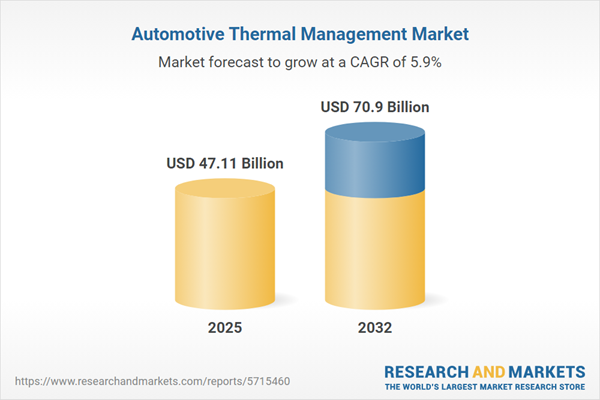Speak directly to the analyst to clarify any post sales queries you may have.
The automotive thermal management market is transforming as electrification, operational efficiency, and sustainability reshape industry priorities worldwide. Senior decision-makers are navigating technology shifts and evolving regulations while aligning strategies for enduring growth and resilience in a dynamic sector.
Market Snapshot: Automotive Thermal Management Market Size and Momentum
The automotive thermal management market is projected to achieve a size of USD 70.90 billion by 2032, up from USD 44.75 billion in 2024, reflecting a compound annual growth rate of 5.91%. This upward trend is driven by increased adoption of advanced powertrains, heightened interest in innovative mobility solutions, and intensified demand for energy-efficient vehicle climate control. Manufacturers are investing in system modularity and platform integration, enabling customized solutions for hybrid, battery-electric, and fuel cell vehicles. With evolving safety requirements and regulatory standards, procurement and design teams are closely monitoring mandates that influence investment and supply decisions.
Scope & Segmentation: Automotive Thermal Management Solutions
- Product Segments: Battery thermal management (air- and liquid-cooled), fans, blowers, condensers, intercoolers, radiators, oil coolers, compressors, heater cores, evaporators, charge air coolers, thermal interface materials—all designed for precise temperature regulation and adaptability across modern automotive platforms.
- Propulsion Types: Addresses unique thermal demands in battery electric vehicles, plug-in hybrids, fuel cell systems, and internal combustion engines, each requiring specific system calibrations for reliable performance.
- End Users: Serves OEMs and aftermarket organizations managing sourcing, product evolution, and supplier partnerships within an advancing technological landscape.
- Distribution Channels: Includes direct sales, distributor networks, and online procurement, ensuring product access and continuity across fluctuating market cycles.
- Vehicle Types: Encompasses commercial trucks, off-road vehicles, hatchbacks, sedans, and SUVs, adapting solutions to variable climates, operational environments, and application-specific needs.
- Regional Coverage: Extends across the Americas, Europe, Middle East, Africa, and Asia-Pacific, with focused perspectives on key markets such as the United States, China, India, Germany, Brazil, Japan, the United Kingdom, and UAE. Analysis considers local standards, infrastructure progress, and climate influences.
- Technologies and Applications: Utilizes air and liquid cooling, phase change materials, advanced digital controls, and robust thermal interfaces to optimize cabin, battery, and electronic component temperatures.
- Company Coverage: Highlights leaders including BorgWarner Inc., Denso Corporation, 3M Company, Continental AG, Valeo Group, and Robert Bosch GmbH, recognized for technical expertise and adaptable solutions.
Key Takeaways for Senior Decision-Makers
- Integrating hardware with digital platforms enables compliance with evolving regulations and boosts operational flexibility.
- Modular system architectures allow rapid adaptation and streamlined product rollouts for emerging vehicle technologies and diversified propulsion methods.
- Incorporating advanced polymers and composites supports lighter vehicle builds, longer operational lifespans, and sustainability-led procurement initiatives.
- Implementing real-time monitoring and analytics enhances reliability and delivers timely insights for responsive, evidence-based decisions.
- Customizable solutions support regional needs and ensure compliance, optimally serving global and local market requirements with efficiency.
- Strengthening collaboration among OEMs, technology providers, and suppliers minimizes supply chain disruptions as industry dynamics evolve.
Tariff Impact: Navigating New Trade Pressures
New United States tariffs on automotive components have prompted organizations to re-evaluate global supply chains and sourcing. Businesses are prioritizing nearshoring strategies and reassessing inventory management to sustain operations and mitigate trade-related risks. This trend elevates the importance of resilient supplier relationships during ongoing shifts in international trade policies.
Methodology & Data Sources
This market analysis leverages direct interviews with industry professionals, technical literature reviews, and verified regulatory and market data sources. Both quantitative and qualitative perspectives inform strategic recommendations for leaders addressing market changes.
Why This Report Matters for Your Strategic Planning
- Presents actionable insights by region and technology, empowering executive teams to make informed market-entry and product roadmap decisions amid ongoing transformation.
- Reveals collaboration and innovation opportunities, guiding investment towards areas with the highest impact against complex new mobility requirements.
- Equips procurement and supply professionals with validated strategies to enhance supplier engagement and manage risk as vehicle system complexity increases.
Conclusion
Successful adaptation and robust collaboration ensure organizations remain competitive and responsive in automotive thermal management. Strategic agility empowers industry leaders to address shifting challenges and maintain continued growth.
Additional Product Information:
- Purchase of this report includes 1 year online access with quarterly updates.
- This report can be updated on request. Please contact our Customer Experience team using the Ask a Question widget on our website.
Table of Contents
3. Executive Summary
4. Market Overview
7. Cumulative Impact of Artificial Intelligence 2025
Companies Mentioned
The companies profiled in this Automotive Thermal Management market report include:- BorgWarner Inc.
- Denso Corporation
- 3M Company
- Advanced Thermal Solutions, Inc.
- Arkema S.A.
- Continental AG
- Dana Incorporated
- Delta Electronics, Inc.
- Dober
- Gentherm Incorporated
- Grayson Automotive Services Limited
- Hanon Systems
- HELLA GmbH & Co. KGaA by Faurecia
- Infineon Technologies AG
- Kendrion NV
- Koninklijke DSM N.V.
- MAHLE GmbH
- Marelli Holdings Co., Ltd.
- Modine Manufacturing Company
- Norma Group
- Robert Bosch GmbH
- Schaeffler AG
- Solvay S.A.
- Thermal Management Solutions Group
- TitanX Holding AB
- Valeo Group
- Voss Automotive
- Ymer Technology AB
- ZF Friedrichshafen AG
Table Information
| Report Attribute | Details |
|---|---|
| No. of Pages | 196 |
| Published | November 2025 |
| Forecast Period | 2025 - 2032 |
| Estimated Market Value ( USD | $ 47.11 Billion |
| Forecasted Market Value ( USD | $ 70.9 Billion |
| Compound Annual Growth Rate | 5.9% |
| Regions Covered | Global |
| No. of Companies Mentioned | 30 |









